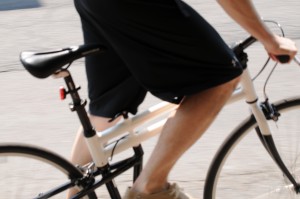 If you’re going to spend any length of time on a bicycle, it’s really important to find a saddle that’s comfortable for you. While the general fit and size of the bicycle will play an important role in how you feel on your bike, the saddle is a major contact point and cannot be ignored. In fact, you could go so far as to say that an uncomfortable saddle refuses to be ignored.
If you’re going to spend any length of time on a bicycle, it’s really important to find a saddle that’s comfortable for you. While the general fit and size of the bicycle will play an important role in how you feel on your bike, the saddle is a major contact point and cannot be ignored. In fact, you could go so far as to say that an uncomfortable saddle refuses to be ignored.
Why is it called a “Saddle” and not a “Seat”?
An excellent question. The eminent Sheldon Brown, fount of cycling wisdom, makes the following distinction between the two:
A seat is something you sit on, and is designed to bear essentially your entire weight. Recumbent bicycles have seats, but conventional upright bicycles have saddles. A saddle is intended to carry some, but not all of your weight. The rest of your weight is mainly carried by your legs, and some by your hands and arms.
The take-home lesson here is that a bicycle saddle is not a seat – it’s not designed to bear all of your weight, so if that’s what you try to make it do, you’ll likely experience some discomfort.
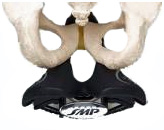 Your typical saddle provides support underneath the sit bones. But most saddles also put some pressure on the soft tissue in between, which is where most people experience discomfort. In order to combat this, many saddles (including those found on Montague folding bikes) have a centre groove or cut-out. The degree to which this solves the problem for you will depend on your posture, riding style, positioning of the saddle on the bike, and a myriad of other factors; you might need to do some experimenting. It can definitely be a process.
Your typical saddle provides support underneath the sit bones. But most saddles also put some pressure on the soft tissue in between, which is where most people experience discomfort. In order to combat this, many saddles (including those found on Montague folding bikes) have a centre groove or cut-out. The degree to which this solves the problem for you will depend on your posture, riding style, positioning of the saddle on the bike, and a myriad of other factors; you might need to do some experimenting. It can definitely be a process.
Padding: Plush or Spartan?
 Saddles also come with different degrees of padding, from a thick foam or gel to leather to hard plastic, and just about everything in between. In your search for a comfortable saddle, you might be tempted to go with the most heavily padded one you can find. Strangely enough, heavy padding doesn’t always turn out to be the most comfortable: the longer your ride, the more your sit bones sink into that pad or gel (and the thicker it is, the more you sink). As this happens, the soft tissue in the groin area actually has more sustained contact with the rest of the saddle (the sides are sinking, and the middle isn’t, which brings you into closer contact with the saddle surface – and that soft tissue can’t tell whether that surface is hard or soft – it feels only friction and pressure). Heavily padded saddles can also cause chaffing on the inner thighs. So if you find yourself doing longer rides, you may find you prefer something with moderate, light, or even no padding. (And you might find the padding migrating from your saddle to your shorts). But if you stick to mostly short rides, say a half-hour at a time or less, you probably won’t notice any of the ill-effects of a heavily padded saddle, and it may well be the saddle for you.
Saddles also come with different degrees of padding, from a thick foam or gel to leather to hard plastic, and just about everything in between. In your search for a comfortable saddle, you might be tempted to go with the most heavily padded one you can find. Strangely enough, heavy padding doesn’t always turn out to be the most comfortable: the longer your ride, the more your sit bones sink into that pad or gel (and the thicker it is, the more you sink). As this happens, the soft tissue in the groin area actually has more sustained contact with the rest of the saddle (the sides are sinking, and the middle isn’t, which brings you into closer contact with the saddle surface – and that soft tissue can’t tell whether that surface is hard or soft – it feels only friction and pressure). Heavily padded saddles can also cause chaffing on the inner thighs. So if you find yourself doing longer rides, you may find you prefer something with moderate, light, or even no padding. (And you might find the padding migrating from your saddle to your shorts). But if you stick to mostly short rides, say a half-hour at a time or less, you probably won’t notice any of the ill-effects of a heavily padded saddle, and it may well be the saddle for you.
Width: Fat or Skinny?
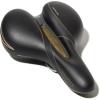 Regardless of how much padding you opt for, width may prove the most important factor in determining which saddle is right for you. Ideally, the saddle will be as wide as the sit bones. Any narrower, and all of the pressure is on your soft tissue, too wide, and you can experience unpleasant chaffing as you pedal. Tempting as the convenience of internet purchasing can be, when you’re looking for a saddle that’s the right width for you, your best bet is to go down to your local bike shop and try some out.
Regardless of how much padding you opt for, width may prove the most important factor in determining which saddle is right for you. Ideally, the saddle will be as wide as the sit bones. Any narrower, and all of the pressure is on your soft tissue, too wide, and you can experience unpleasant chaffing as you pedal. Tempting as the convenience of internet purchasing can be, when you’re looking for a saddle that’s the right width for you, your best bet is to go down to your local bike shop and try some out.
A quick tip for the ladies: because most women have wider hips than most men, most women will probably be more comfortable on wider saddles. The reason for this is that the wider the hips are, the more space there is between the sit bones.
Should it have Suspension?
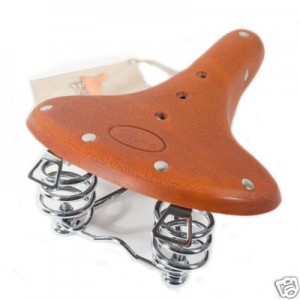 Again – it depends on you and where you’re riding. If you don’t like feeling the bumps in the road in your butt, get a spring loaded saddle, and you’ll probably be a lot more comfortable. But at the same time, you’ll lose a little bit of efficiency . This probably isn’t a big deal unless you’re planning to race, in which case you probably don’t want the spring loaded saddle anyway on account of its weight, and because when you pedal really fast you’ll bounce.
Again – it depends on you and where you’re riding. If you don’t like feeling the bumps in the road in your butt, get a spring loaded saddle, and you’ll probably be a lot more comfortable. But at the same time, you’ll lose a little bit of efficiency . This probably isn’t a big deal unless you’re planning to race, in which case you probably don’t want the spring loaded saddle anyway on account of its weight, and because when you pedal really fast you’ll bounce.
If you really don’t like feeling the vibrations, you can combine a spring-loaded saddle with a suspension seat post. Or if you’re mountain biking and want to stick with a regular saddle, you can use a suspension seat post to reduce some of the vibrations.
What if I don’t like the Saddle that comes on my Folding Bike?
All Montague saddles are padded and have either a cut out or centre groove for comfort. We do our best to choose a saddle that balances comfort, weight, and performance, but it would be impossible to find a saddle that suits everyone.
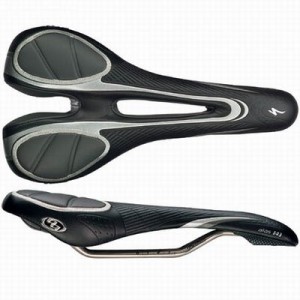 Breaking in a saddle is like breaking in a new pair of shoes. If your saddle doesn’t feel great the first time you ride it, give it a chance, and you might find it a lot more comfortable after the first few rides. If, on the other hand, you get on the saddle and it’s actually painful, it’s probably not the right saddle for you (sometimes, the shoes just pinch in the toes). If this is the case, we’re sorry that our saddle didn’t work for you, and it’s time to head on down to your local bike shop to check out the alternatives. On the bright side, a saddle is a comparatively inexpensive part to replace (you can generally find a perfectly adequate saddle for $30 or less), and you’ll probably be able to install it yourself.
Breaking in a saddle is like breaking in a new pair of shoes. If your saddle doesn’t feel great the first time you ride it, give it a chance, and you might find it a lot more comfortable after the first few rides. If, on the other hand, you get on the saddle and it’s actually painful, it’s probably not the right saddle for you (sometimes, the shoes just pinch in the toes). If this is the case, we’re sorry that our saddle didn’t work for you, and it’s time to head on down to your local bike shop to check out the alternatives. On the bright side, a saddle is a comparatively inexpensive part to replace (you can generally find a perfectly adequate saddle for $30 or less), and you’ll probably be able to install it yourself.
A Quick Note on Installation and Adjustment
While most saddles attach with just a simple bolt or two, you can’t just slap the saddle on the bike. You’ll want to take into account the height of the saddle (how high is it off the ground?), the angle (it should be more-or-less flat – if the nose is pointed noticeably up or down, you could be in for some serious discomfort, even with the world’s most comfortable saddle) and setback (how far away is the saddle from the handlebars?). In terms of riding comfort, saddle adjustment can be as important as saddle selection, so spend a little time making sure not only that your butt doesn’t hurt, but that your knees and back feel comfortable as well.
What’s Your Advice on the Saddle-Front?
How long did it take you to find your favourite saddle, or are you still searching? What’s the most important feature of the saddle to you? Do you have any tips to make the adjusting process easier?


I understand that the Crosstown bike has a heavier capacity. I would like to know what the maximum weight capacity is for the Montague Crosstown as I weigh about 210 lbs and I may plan to install a baby seat for my child as well. At other times, I also carry about a work bag weighing 15-20 lbs so I would consider installing a rack.
Thank you.
Hi
I bought a Montague X50 and I’m pleased with the quality of it, but I definitely need a new, more comfortable saddle. I’m really new to all of this, but think I can find the type of saddle I need; the question is …..is there any particular type of mechanism/fixing that relates to my bike in terms of a replacement, or are all saddles universal?
All bike saddles are indeed universal. You can mount any aftermarket saddle on your seatpost. Most bike shops will let you try out a few different saddles to find one that’s comfortable for you. It is the most often customized part on most bikes as everyone is different.
Hi looking to order 6 of the mountain bikes for the family on line to have them shipped to meet us on the road. These will be for 2 grown adults one male about 6′ one female about 5’6..another 16 year old girl 5’6, one 15 yr. old girl 5’4, one boy 13 yrs. 5’5 and one girl 11 yrs. 4’10. What size frames would you recommend? Thanks!! Jeff
Hi Jeff. We do not make any children’s bicycles and our bikes should not be ridden by anyone under 14 years of age. Regarding frame sizes, you can use the following recommendations for all models:
Small (16″/17″): 4’8″ – 5’2″
Medium (18″/19″): 5’3″ – 5’10”
Large (20″/21″): 5’11” – 6’4″
Hello, on the paratrooper pro 16″, is the saddle height adjustable up or down.
Yes, the saddle height is fully adjustable with a quick release clamp. We typically recommend you slide the seatpost and saddle all the way down when folding the bike in order to create the smallest folded size possible.